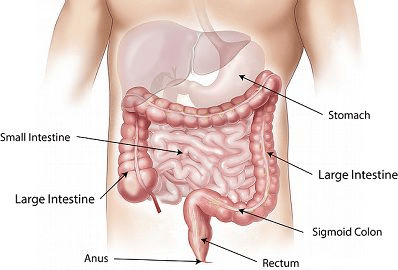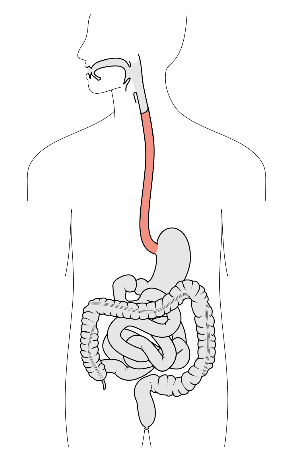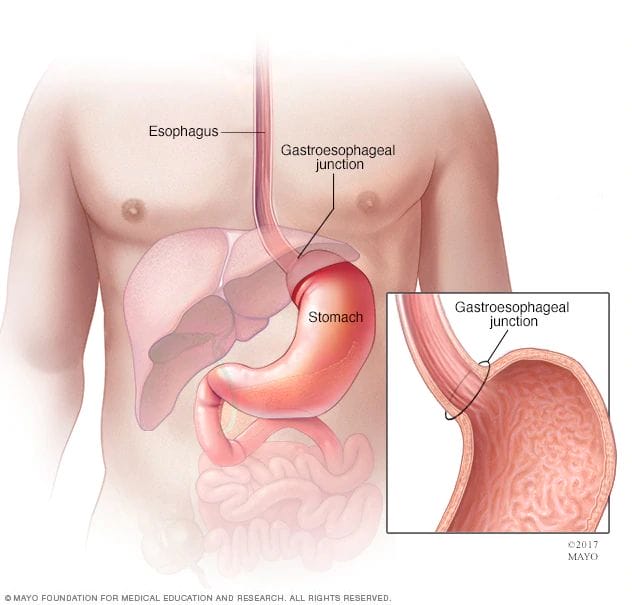GUT ANATOMY 101
What comprises the gut?

Our gut (digestive tract) consists of the mouth, esophagus, stomach, small and large intestine, colon and rectum.
The small intestine
The small intestine is an organ that is actually twenty feet long. This is the area where the majority of our nutrients are absorbed and digested. It is also a great area for hosting gut bacteria.
The large intestine
The large intestine plays a role in detoxification and electrolyte stability. It is the final stage of digestion. It is an area where a lot of water is absorbed from the remaining indigestible food and transmits the excess waste material from the body. The large intestine includes the colon, rectum and anus.

Digestion: From chewing to pooping – putting it all together
Mouth: saliva is produced and helps break down what you’re eating and turns it into chemicals called enzymes
Esophagus: once food is broken down and chewed it moves through this tube-like structure that connects from the mouth to the stomach.

Stomach: This is where food ends up next! The stomach acid and enzymes in the stomach help further break down the food that was previously chewed. Then the food moves to the small intestine.

Small intestine: Food is broken down by enzymes that are released from the pancreas and bile from the liver.
Large intestine: The digested food continues to the large intestine. Although we now have digested food particles in our intestine this does not mean that all of the nutrients from the food was absorbed prior to getting here! So all the excess waste aka food we aren’t absorbing and assimilating continue to pass through the digestive tract into the colon and leave the body via bowel movements.
Now that we have a better understanding of the basic anatomy of our gut. We must consider a very important factor that lives within our gut walls. Within the small intestine lies over 100 trillion living bacteria and these are our vili and microvilis. They are hairlike projections that line the intestinal walls. There are roughly 3-5 pounds of these living bacteria in our guts known as our microbiome! Their role is to help increase surface area available for the absorption of nutrients. Ali Miller, a registered dietician, and functional medicine practitioner explains it very simply:
“The best way to understand the microbiome is to envision a garden bed. There is only so much room for things to grow. You will see the beneficial vegetation you intended to grow, wildflowers and weeds. In some cases, the garden bed is filled with so many weeds or even overgrown wildflowers that there is no room for intended vegetation to thrive…(…)…One must plow the fields of the garden bed to allow space for good bacteria to thrive and then fertilize and support healthy growth” for positive effects. From mood stability to immune health to digestive function, the microbiome plays a critical role in expression of overall health or disease state.”
So, with that said, our microbiome has the ability to work with or against “the host” which would be the body that it lives in (aka yours!). So, when we have more “vegetation” aka good bacteria, we can see a reduction in inflammation, less GI stress, improved digestion, stronger immune system and an increase in nutrition absorption. When there’s too many wildflowers or weeds we have the opposite of what was previously mentioned. We have too much of an imbalance throughout the body. We can see some GI stress like gas, bloating, burping, diarrhea and increases in micronutrient deficiencies because of the lack of absorption. These negative effects take place within the small and large intestine. So, we definitely want to focus on getting our body into a more optimal state to support whole body health! Can you see how this effects, and may play a role in health-related issues such as SIBO, Candida overgrowth, IBS, Crohn’s and autoimmune diseases?
SIBO: Small intestinal bacterial overgrowth: SIBO is a medical condition in which there is an overgrowth of bacteria found in one’s small intestine. It’s when bacteria start appearing there when normally it’s grown in other parts of our gut. This large population of bacteria is commonly found in the colon! Therefore, it isn’t just one form of bacteria that causes this but various types. SIBO can also be a result of other conditions that have caused it to arise in part with digestive issues like IBS, Celiac and Crohn’s disease. SIBO can also occur due to lack of movement through the intestine and poor eating habits.
Candida Overgrowth is in short, a yeast infection. However, yeast infections can come in many forms in and on the body in multiple areas. For example, ringworm, athletes’ foot, mouth, vaginal, rectum, within your intestines and skin. There are a few factors that can cause Candida such as, high sugar intake, oral contraceptives, high stress levels, antibiotic use and an imbalance in vaginal flora.
Crohn’s Disease: As defined by Mayo Clinic, “is an inflammatory bowel disease (IBD). It causes inflammation of your digestive tract, which can lead to abdominal pain, severe diarrhea, fatigue, weight loss and malnutrition. Inflammation caused by Crohn’s disease can involve different areas of the digestive tract in different people.”
IBS: Irritable Bowel Syndrome: As defined by Mayo Clinic, “Irritable Bowel Syndrome (IBS) is a common disorder that affects the large intestine. Signs and symptoms include cramping, abdominal pain, bloating, gas, and diarrhea or constipation, or both.”
In the upcoming posts we will learn how to achieve a stronger gut-lining, how we can recover and hopefully get rid of our chronic health ailments. Stay tuned for next week where I explain what daily food, drinks, and oral medications we ingest that make our intestinal walls more permeable and we will also discuss the two states our guts can be in. Curious to see if you have a bed of weeds or natural vegetation brewing in your gut? If so, stay tuned 🙂

